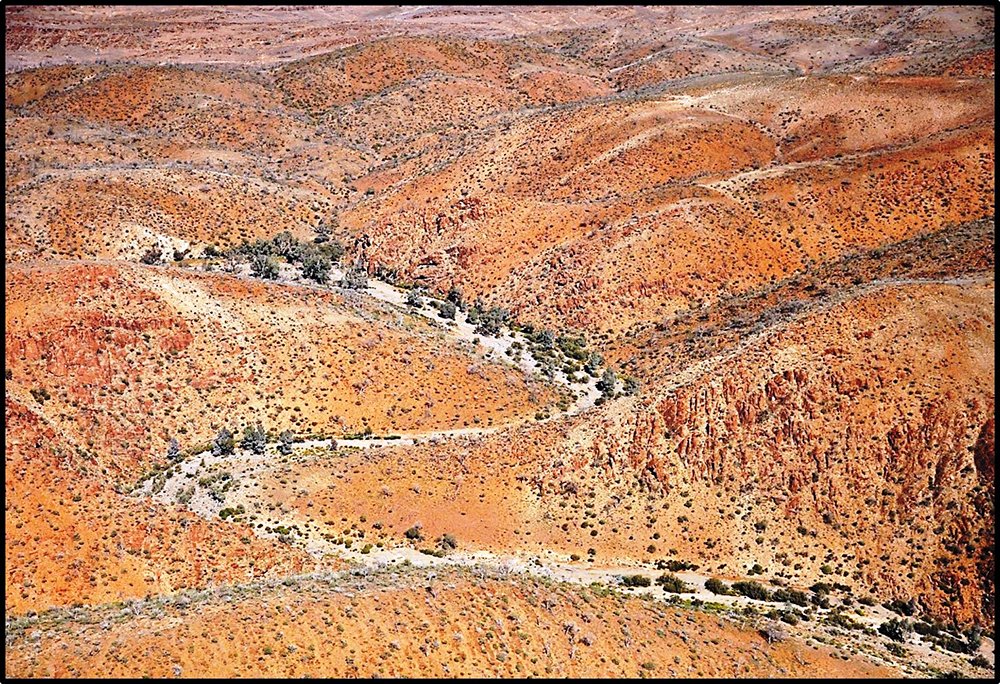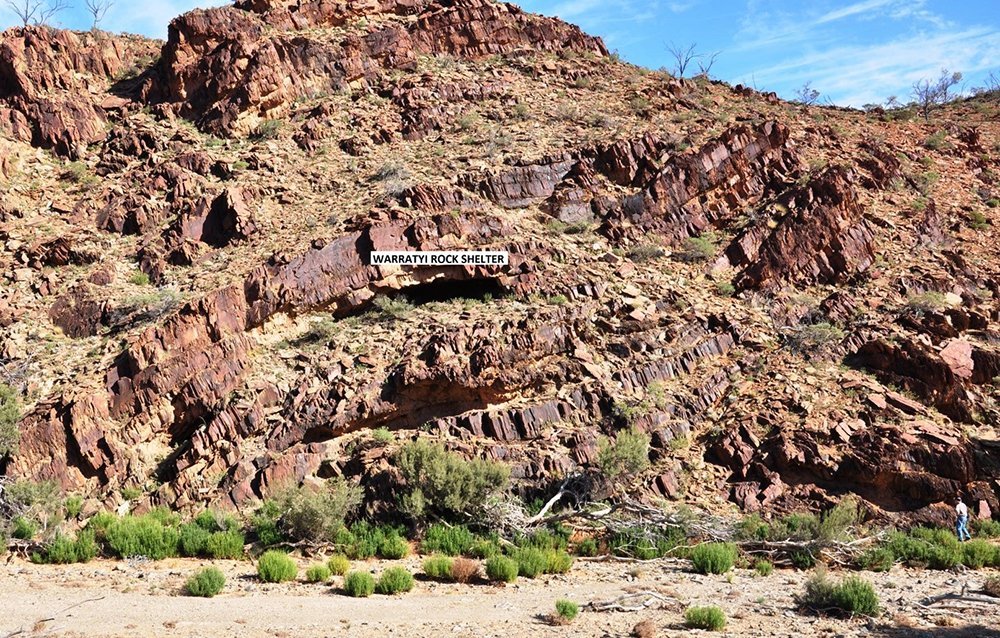Rock shelter provides earliest evidence of humans in the outback

John Pickrell
John Pickrell

PEOPLE RAPIDLY SET OUT to settle the arid inland of Australia after arriving on the continent 50,000 years ago, says a team of researchers that found the oldest yet evidence of human occupation in South Australia.
The discoveries were made at a rock shelter 20m up a slope in the Adnyamathanha Aboriginal country of the northern Flinders Ranges, about 550km north of Adelaide.
These finds of complex tools, animal bones, eggshells and the remains of cooking fires push back the known date of settlement of the outback by 10,000 years, showing that people were living and hunting in the Flinders Ranges 49,000 years ago. The remains also suggest that people were then already decorating their bodies with red ochre and white gypsum.
“Our evidence shows that people not only settled in the arid interior within a few millennia of entering the continent, but also developed key technologies much earlier than previously recorded for Australia and Southeast Asia,” write the authors of a paper detailing the finds today in the journal Nature.

A sharpened bone point that is 40-38,000 years old and is now the oldest bone tool known in Australia. Likely hewn from the leg bone of a yellow-footed rock wallaby. (Credit: Giles Hamm)
Settlement of the Flinders Ranges
Giles Hamm, a PhD candidate at LaTrobe University in Melbourne, began to study the area around the Warratyi rock shelter around nine years ago. He was hoping to push back the known dates for Aboriginal settlement of the Flinders Ranges, then thought to stretch back no more than 15,000 years.
“Towards the end of my research – having felt quite depressed and lonely – I came across this rock shelter when we were doing a routine survey. We’d found a spring… which had a lot of rock art around it… We did a series of surveys adjacent to that spring and that’s what led us to Warratyi,” he said.
“We walked along this gorge, we looked up, and there was a blackened wall – and we knew that was an indication of people firing inside the shelter. Then we walked up this very steep slope and suddenly found all these stone artefacts lying around.”
Giles and co-worker Clifford Coulthard from the Adnyamathanha Traditional Lands Association entered the rock shelter and used a probe to determine the soil on the floor was at least one metre deep and contained a lot of ash and charcoal – a discovery which made Giles’s heart pound with excitement.

The landscape of the northern Flinders Ranges. (Credit: Giles Hamm)
A range of different dating methods
Subsequently the team of experts and Adnyamathanha people dug several trenches across the shelter floor removing nearly three tonnes of soil; in the process they discovered 4300 artefacts and 3kg of bone as well as lots of plant matter, eggshell, ochre and charcoal.
Initial guesses were that the remains covered a period of time stretching back perhaps just 5000-6000 years. “There’s no way that we thought a metre of deposit would go back so far” said Giles. “The first inkling that we knew it was old, was when we got these emu eggshell dates back starting in the 20-something thousands. And then it just kept getting older and older.”
Determining a reliable chronology is critical “because chronology has proved to be contentious issue in understanding early settlement of Australia,” said Dr Lee Arnold of the University of Adelaide, who carried out detailed work to determine the age of the discoveries.
The scientists used several dating methods including a technique known as OSL (optically stimulated luminescence) and radiocarbon dating. They also tested the age of several different kinds of eggshell, bone and quartz grains in the remains of cooking fires. This resulted in individual dates for 20 different layers across the metre depth of the sediments.

Profile view of Warratyi Rock Shelter elevated above local stream catchment. (Credit: Giles Hamm)
Aboriginal settlement of Australia
While the environment of the Flinders Ranges was well within the arid zone 49,000 years ago – as it is today – it would then have been wetter, with a much richer variety of plants and animals. This offers a clue as to how people were able to colonise outback Australia very rapidly after arriving in the Top End.
“In terms of inland occupation, [the site is] significant geographically,” said Giles. “It shows that people are moving very quickly around the continent and in the interior part of the continent. If people are coming in at 50,000 [years ago], it means that people are moving in a whole range of directions.”
People arrived in Australia in the north from Asia and first settled tropical regions such as The Kimberley, Arnhem Land and the region around the Gulf of Carpentaria.
Despite barriers slowing their progress south – such as the Tanami, Great Sandy and Simpson deserts – Giles believes people were able to follow major river systems and lakes at a time when there was more water around in the environment. “They were like migration corridors. I think they took a… north-south migration route once they’d settled in the north and their populations got to a level that might have triggered the need to move and open up new country.”
Archaeologist Giles Hamm talks about his discovery in the Flinders Ranges.
“A narrative about the conquest of the deserts”
“Australia is the driest continent to have ever been settled by modern peoples. The fact they penetrated so far inland and so quickly from northern landing points, means they had well-developed subsistence practices,” commented Professor Peter Veth an archaeologist and expert on rock art at The University of Western Australia.
“50,000 years ago Australia was experiencing a wetter climate and the connectivity of waters into the interior probably provided rapid conduits for peoples to expand,” he said. “The story of Australia is a narrative about the conquest of the deserts.”
Furthermore, the discovery of bones of extinct megafauna – such as the giant marsupial Diprotodon optaum – provide the best evidence yet that humans were hunting and eating these species, and that they may have a had a role in their extinction, said co-author palaeontologist Dr Gavin Prideaux of Flinders University in Adelaide.
This cave was too high for Diprotodon to have reached and the bones don’t display the gnaw marks expected if they were the remains of a carnivorous animal’s meal. This led the researchers to surmise these animals had been caught and eaten by humans.
The discovery “undermines one of the supposed pillars of support for climate change, not humans, causing the extinctions – because humans evidently lived alongside these animals and hunted them,” said Gavin. “And so the idea that there weren’t any interactions between humans and these animals is put to bed now by this Warratyi evidence.”

Extinct marsupuial herbivore Diprotodon. (Credit: Peter Murray)
Good evidence of Aboriginal hunting of megafauna
Dr Michael Westaway a palaeoanthropologist at Griffth University in Queensland, who was not involved in the research, agrees it good evidence that people were hunting megafauna. “There is next to no evidence of this in Australia – particularly when compared to Europe and America – so this is really important and just goes to show how very little we know about human megafauna interaction,” he said.
Michael added that, this very significant study “exposes how little we know about ancient Aboriginal Australia, and how the first inhabitants were highly sophisticated hunter-gatherers that were able to efficiently adapt to the arid regions of the country very quickly after settlement. There is a Eurocentric view that material culture in Australia is quite simplistic and backward some 50,000 years ago, so this research helps rewrite that story.”
The Adnyamathanha people of the northern Flinders Ranges are thrilled with the findings and have a real interest in this work, says study co-author and Adnyamathanha man Clifford Coulthard. Talking specifically about the discovery that people had been here for 49,000 years, he said: “It wasn’t really a surprise. A lot of the old people said our people had been here a long time.”
John Pickrell is the author of Flying Dinosaurs and Weird Dinosaurs. Follow him on Twitter @john_pickrell.




